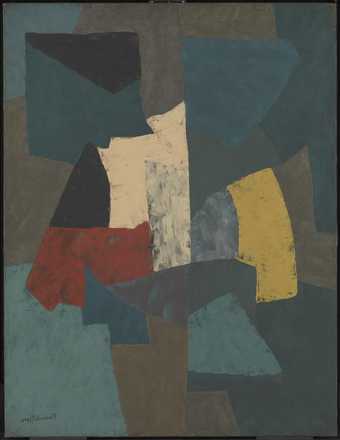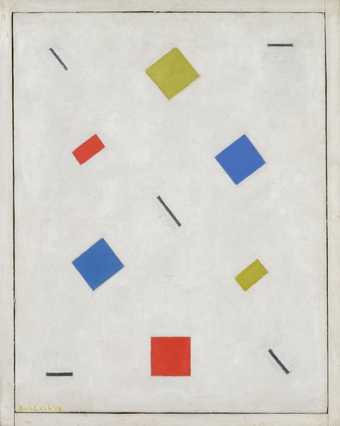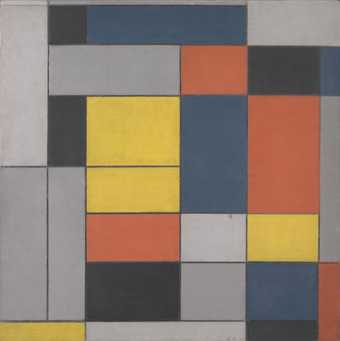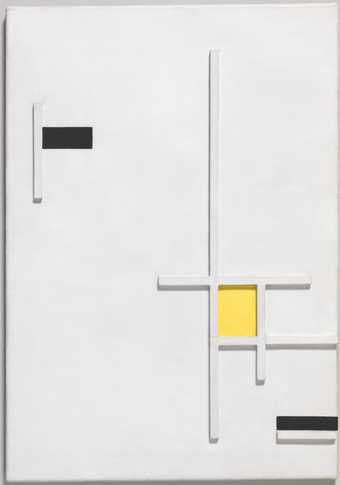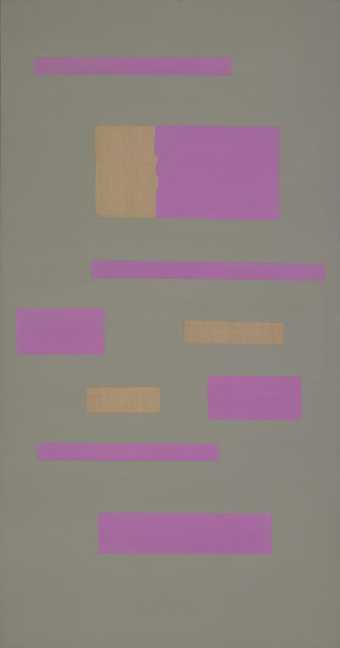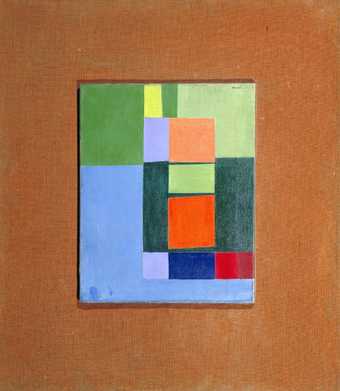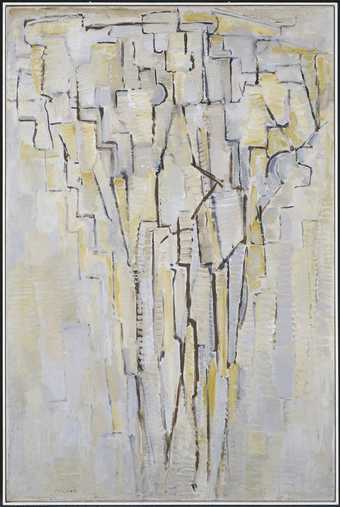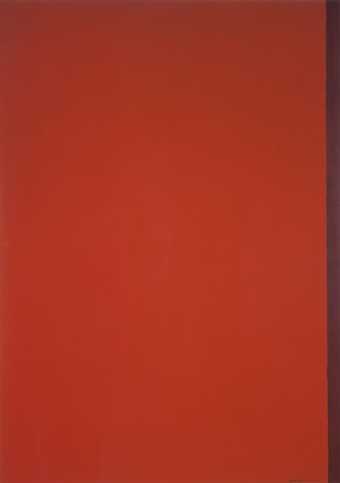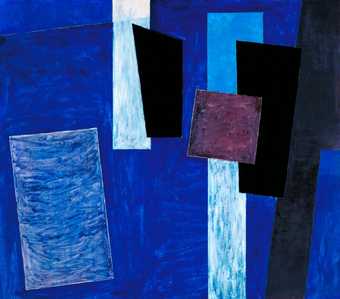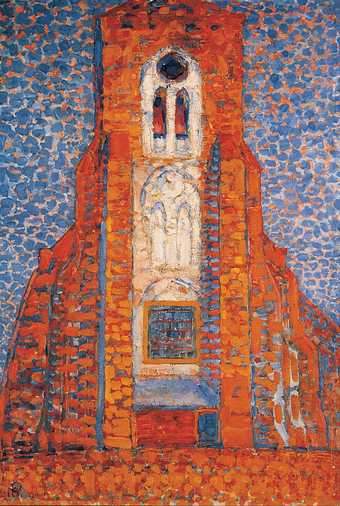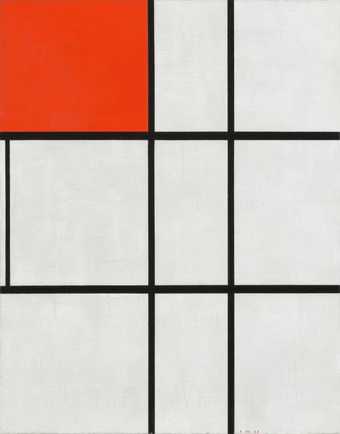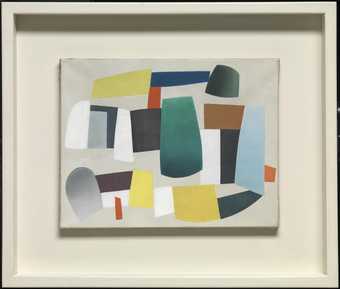
Not on display
- Artist
- Piet Mondrian 1872–1944
- Medium
- Oil paint on canvas
- Dimensions
- Support: 727 × 692 mm
frame: 917 × 882 × 63 mm - Collection
- Tate
- Acquisition
- Purchased 1964
- Reference
- T00648
Display caption
Mondrian’s interest lay in the abstract quality of line but by 1914 he had all but eliminated the curved line from his work. By 1916 he had suppressed any sense of a subject. Still later he developed a new form of rigorous abstraction called Neo-Plasticism in which he limited himself to straight, horizontal and vertical lines and basic primary colours. Typically his compositions were not symmetrical but could scarcely be purer in their elements. He felt this art reflected a greater, universal truth beyond everyday appearance.
Gallery label, April 2013
Does this text contain inaccurate information or language that you feel we should improve or change? We would like to hear from you.
Technique and condition
The painting is an unvarnished oil painting on pre-primed canvas, and it is in a very good condition. There is a canvas stamp on the reverse which indicates the use of the French supplier Lefebvre-Foinet. The initial composition was painted in Paris in 1937–38 and developed in New York between 1940 and 1942 when Mondrian added the red, blue and yellow colour fields. Mondrian also repositioned some of the black lines, and added others. The horizontal lines were generally painted before the vertical lines. Mondrian is known to have used brushes, palette knives and a steel bar to achieve his sharp lines.
Pigment analysis has confirmed that the blue paint is a mixture of French ultramarine with titanium white, the red is cadmium red, the yellow is cadmium yellow, the colourants he typically used, the black is bone black with small quantities of lead white, and the white paint is a combination of lead white and zinc oxide and/or zinc sulphide. Analysis of the binding medium of the oil-based cadmium yellow paint shows that beeswax and carnauba wax are present as paint additives. The paint in Composition appears quite thick, and there is a fair amount of craquelure over the paint surface. These age cracks pose no danger to the structural integrity of the painting, and are a normal part of the ageing of oil-based paint. The cadmium yellow paint is water sensitive, and also exhibits slight cadmium yellow deterioration which results in white and brown degradation products, of which tiny patches of brown and white are visible through a low-powered microscope on the cadmium yellow colour field, although most of the cadmium yellow paint is not degraded. Cadmium yellow degradation is caused by oxidation of the pigment over time, and has been observed frequently in nineteenth and twentieth century paintings.
Controlling environmental conditions by minimising exposure to ultraviolet light and/or changes in relative humidity promotes the stability of such paints. The painting is displayed within a non-original frame, fitted with glazing that helps to protect it.
Further reading
Harry Cooper and Ron Spronk, Mondrian: The Transatlantic Paintings, Cambridge/New Haven, 2001.
Geert Van der Snickt et al. ‘Characterization of a Degraded Cadmium Yellow (CdS) Pigment in an Oil Painting by Means of Synchrotron Radiation Based X-ray Techniques’, Anaytical Chemisry, 2009, 81 (7), pp.2600–2610.
Anna Cooper, Water Sensitive Paints in the 20th Century, master thesis, Courtauld Institute of Art, 2012.
Judith Lee
February 2017
Research on this work was undertaken as part of the Cleaning Modern Oil Paints project.
Catalogue entry
Piet Mondrian 1872-1944
T00648 Composition with Red, Yellow and Blue
c.1937-42
Inscribed 'PM' b.l. and '39 | 42' b.r.
Oil on canvas, 28 5/8 x 27 1/4 (72.5 x 69)
Purchased from Mrs Donald Ogden Stewart (Special Grant-in-Aid) 1964
Prov:
Mrs Donald Ogden Stewart (Ella Winter), New York and London (purchased from the artist in 1943 or 1944)
Exh:
Mondrian, Valentine Gallery, New York, January-February 1942 (3) as '1939-42'; Piet Mondrian 1872-1944, Whitechapel Art Gallery, London, August-September 1955 (54, repr. in colour); Mondrian, Sidney Janis Gallery, New York, September-November 1957 (28, repr.); Holländische Maler im 20. Jahrhundert, Kunsthalle, Kiel, June-July 1959 (34, repr. in colour); 3 Ages, Stedelijk Museum, Amsterdam, June-September 1960 (70, repr. in colour); Verzameling Ella Winter, Stedelijk Museum, Amsterdam, December 1961-January 1962 (70, repr.); Piet Mondrian, Nationalgalerie, Berlin, September-November 1968 (72, repr. in colour); Mondrian, Orangerie des Tuileries, Paris, January-March 1969 (97, repr. in colour); Piet Mondrian 1872-1944, Guggenheim Museum, New York, October-December 1971 (126, repr.); Kunstmuseum, Bern, February-April 1972 (109, repr. in colour)
Lit:
Michel Seuphor, Piet Mondrian: Life and Work
(London 1956), No.576, p.431, repr. p.393 (c.c.415); Ella Winter, 'I bought a Klee' in Studio International, CLXXII, 1966, p.24; Michel Seuphor, Piet Mondrian: sa Vie, son Oeuvre
(Paris 1970), No.608, p.428, repr. p.393 (c.c.415); Virginia Pitts Rembert, Mondrian, America, and American Painting
(unpublished PhD thesis, Columbia University, New York 1970), p.301, repr. figs.26-7; Maria Grazia Ottolenghi, L'Opera Completa di Mondrian
(Milan 1974), No.453, p.115, repr. p.115 and pl.41 in colour; Robert Welsh, 'The Place of "Composition 12 with Small Blue Square" in the Art of Piet Mondrian' in The National Gallery of Canada Bulletin, 29/1977, 1978, pp.27, 31, repr. pls.18 (unfinished) and 19
Repr:
Frank Elgar, Mondrian
(London 1968), pl.179; L.J.F. Wijsenbeek, Piet Mondrian
(London 1969), pl.123 in colour
The double date 1939-42 inscribed on this work would seem to show that this picture was begun during Mondrian's stay in London and finished after his move to New York, but Robert P. Welsh has discovered that it appears in a photograph of Mondrian's Paris studio taken by the Dutch photographer Oorthuys in 1937 or 1938 (repr. Welsh, op. cit., pl.18), and was therefore actually begun in Paris. This would account for the fact that it is painted on a French canvas with the stamp of the art supplier Lefebvre-Foinet. The photograph shows it mounted on a backboard and leaning against the wall. The very bottom, from the bottom of the red rectangle downwards, is concealed from view but there seems no doubt that it is this picture, despite a number of differences. The four black horizontal bands appear to be the same as those in the finished picture; on the other hand it lacks the vertical band on the extreme left and the two on the extreme right (except for a short black stripe to the right of the coloured rectangle). This rectangle, which appears to be red and to be the only note of colour in the picture, does not fill the whole of the present square as the right-hand side is occupied by another vertical black stripe and a narrow band of white. The white areas seem to show smudgy traces of several earlier vertical black lines (possibly only drawn in) in different positions, indicating that the artist had already made some adjustments to the composition, but it is not clear whether the whites had been thinly painted by this stage or were simply the white of the priming.
The finished picture shows various signs of extensive reworking. In particular, it seems that the surface was originally coated with flat paint and that most areas were afterwards overpainted with thicker, creamier paint and with brush-strokes at right angles to the original ones. The yellow rectangle at the top left-hand corner seems to belong to the early, thinly-painted phase, whereas the red square has been overpainted in thicker paint, as have all the larger rectangles of white. At some stage, the edges were taped to hide the tacks and then painted with white, except that the yellow was also carried round the edges. The last elements to be added were almost certainly the blue and red stripes towards the bottom, which are in his late style (as it was only in New York that he began to work with coloured stripes instead of black ones). The initials and date must have been added shortly before the opening of his exhibition at the Valentine Gallery in January 1942, in which almost all the paintings had a double dating ending in '42, and it would seem that he had forgotten by then exactly when it had been begun.
It seems that this picture was started in his very austere style of the latter half of the 1930s as a predominantly linear composition, with only one small rectangle of colour, and that he afterwards made various modifications to it which made it much more colourful and gayer in feeling.
The exact date of the photograph of Mondrian's studio is unrecorded. The page in the Cas Oorthuys album into which it is stuck is annotated 1938, but Mrs Oorthuys believes that it was taken in the year of the Paris International Exhibition, which was 1937. It shows on an easel, as an apparently just completed work, a picture which is signed and dated 1937.
Published in:
Ronald Alley, Catalogue of the Tate Gallery's Collection of Modern Art other than Works by British Artists, Tate Gallery and Sotheby Parke-Bernet, London 1981, pp.535-6, reproduced p.535
Explore
- abstraction(8,615)
-
- non-representational(6,161)
- formal qualities(12,454)
You might like
-
Serge Poliakoff Abstract Composition
1954 -
Bart van der Leck Composition
1918 -
Piet Mondrian No. VI / Composition No.II
1920 -
Marlow Moss Composition in Yellow, Black and White
1949 -
Ad Reinhardt Abstract Painting
c.1951–2 -
Kenneth Martin Composition
1949 -
Piet Mondrian The Tree A
c.1913 -
Barnett Newman Eve
1950 -
Barnett Newman Moment
1946 -
Adrian Heath Composition, Blue, Black and Brown
1952 -
Piet Mondrian Sun, Church in Zeeland; Zoutelande Church Facade
1909–10 -
Piet Mondrian Composition B (No.II) with Red
1935 -
Jean Hélion Abstract Composition
1934 -
Judith Rothschild Untitled Composition
1945 -
Saloua Raouda Choucair Composition with Two Ovals
1951

